Plant hunting in Maremma, Italy
Sunday 5 May to Saturday 11 May 2019
Walking, wild flowers and scenery in Italy

Goffredo Filibeck
The early-May trip to the Maremma in southern Tuscany was our first walking and wild-flower trip in Italy and the weather was perfect: cool and breezy but with hardly any rain.
All 20 participants met at Rome’s Fiumicino airport where we were greeted by our guide, MPG member Goffredo Filibeck, who lives in a village some 70km north of Rome, and our minibus driver Marco. Goffredo works on botanical ecology at the University of Tuscia in Viterbo.
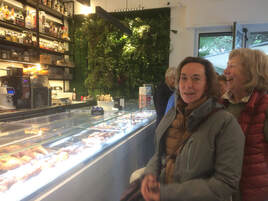
Susan and Joey admiring the pastries in the café in Santa Severa
We drove north for less than an hour before stopping for a delicious lunch at a friendly café in Santa Severa where we chose from a great selection of antipasti, followed by two more courses. There was a downpour as we arrived at the café, but the rain passed quickly so, after lunch, we stopped for a short walk on the lower slopes of Monti della Tolfa in interesting grassland.

Malope malacoides
Road verges were lined with the crimson flowers of Sulla coronaria. In the grassland, we saw plenty of wild artichokes (Cynara cardunculus), as well as Pyrus spinosa, Malope malacoides, Oenanthe globulosa, some wild gladiolus, Allium roseum, the tiny annual Anthemis praecox and a number of orchids, including the showy Orchis purpurea, also some of the horses which run wild in that area.

The horses were curious about us
We then followed a small watercourse. Along its banks we found a carpet of Allium triquetrum still in full flower because of the unusually cold weather, as well as a few specimens of Cyclamen repandum; Goffredo pointed to the twisted, tropical-looking features of the wild fig-tree (Ficus carica) and the wild grapevines (Vitis vinifera subsp. sylvestris) – both of them are typically connected with these gullies along the coasts of C-Italy. Where the gully opened into a larger, stony bed, the creek was lined with Tamarix africana.
It was a welcome walk before continuing on to Hotel La Caletta, right beside the sea in the small seaport of Porto Santo Stefano on the Monte Argentario peninsula. The peninsula is joined to the mainland by two sand spits and a causeway, an area much appreciated by Italians but in early May there were few tourists.
It was blissful to wake on our first morning, Monday 6 May, right beside the sea. All our rooms looked over the sea, as did the restaurant. At breakfast we marvelled at the selection of juices, fruit, pies, tarts, jams, honey, yoghurts, crispbreads and cakes.
Members had been told that to get the best out of the trip they must be happy to walk several kilometres each day. The morning walk, a short drive from our hotel, was about five kilometres on a dirt track with a side extension on a rocky path through Quercus ilex coppice woods and low Rosmarinus officinalis scrub to a limestone peak with wonderful sea views towards Giglio Island, where the Costa Concordia cruise ship was wrecked in 2012, Elba and Montecristo.

Watchtower viewed from main track Ampelodesmos mauritanicus in the foreground

Coris monspeliensis
The track was often lined with tall wispy Ampelodesmos mauritanicus. The garrigue on limestone and the abandoned, terraced olive groves were rich in interesting species, including Linaria purpurea (endemic to Italy), Coronilla juncea (at peak flowering during our visit – it is a western Mediterranean species quite rare in Italy but very abundant here), Coris monspeliensis (a strange-looking western Mediterranean plant from Primulaceae, found only in very dry open scrublands) and a number of specimens of Cytinus.
Cytinus are parasitic on the roots of cistuses. The infloresence appears in spring as a brightly coloured fleshy cluster of flowers at ground level, sometimes hidden below the base of the bush. The plant spends the rest of the year living underground and the flowers can be seen only for a very short time in April and early May. Goffredo was back here with his students some 10 days later and the flowers were already starting to wither.

Cytinus hypocistis subsp. clusii
The yellow and red Cytinus hypocistis subsp. hypocistis prefers to grow on the white Cistus salvifolius or Cistus monspeliensis. The white and red Cytinus ruber (= C.hypocistis subsp. clusii) is mainly found on the larger-flowered deep pink Cistus creticus subsp. eriocephalus. Cytinus was formerly included in the Rafflesiaceae which is a mainly tropical parasitic family best known for producing the largest flower in the world, Rafflesia arnoldii but there is now a separate family known as Cytinaceae.

Cytinus hypocistis subsp. hypocistis

Ophrys bertolonii
Although our visit was a bit late in the year for most of the orchids for which Monte Argentario is famous, we spotted a few species including Orchis italica and Ophrys bertolonii.
We returned to the outskirts of Porto Santo Stefano at the end of the morning. The white-flowering Allium subhirsutum was blanketing the road verges. On the way, our driver pointed out a tall slim tower, from which the inhabitants used to keep watch for pirates. Apparently it has no door and it’s assumed that those on duty used to go in and out at the top, using a rope lift system.
Lunch was in a specialist fish restaurant at the back of an old garage in an inauspicious area, and was one of the most delicious meals of the trip. Fish is caught locally and landed at the port in Porto Santo Stefano every day. Bonuses were that a printed menu was provided and one of the dessert choices was the most gorgeous panna cotta I’ve ever tasted. No gelatine!

Antirrhinum latifolium
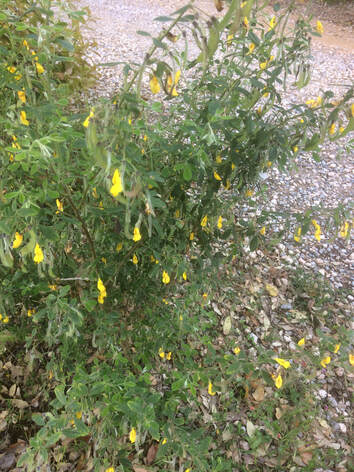
Cytisus villosus
In the afternoon we walked through woodland on the north-east slopes of Monte Argentario. We passed a rocky bank of Antirrhinum latifolium, in flower. Further up, Goffredo pointed out the yellow broom, Cytisus villosus, also in flower, growing close to cork oak (Quercus suber), with which it is often associated. Lathyrus venetus was in flower in the wood fringes. A few specimens of wild bay laurel (Laurus nobilis) could be seen along the creeks crossing the trail. There were wonderful views from this site, often improved by one or several beautiful Pinus pinea pines.

Looking towards the mainland across the Orbetello lagoon
In the evening we were joined by Laura Cancellieri, a colleague of Goffredo, who had driven from Rome to join us and was valuable identifying plants and preventing any of our group getting lost the following day on Giglio Island.
We set out earlier than usual on the Tuesday to take the nine o’clock ferry to Giglio. It was a cool sunny day, very calm which was perfect for the one-hour crossing. We took three minibuses from the port up to Giglio Castello, which is located at one end of the main granite ridge of the island. The group first climbed up a ridge near Giglio Castello, across Pinus pinea afforestation whose herb layer featured Aristolochia lutea, Arisarum vulgare and the curious moss-looking fern Selaginella denticulata.
From the top of the ridge there was a spectacular view over Giglio Porto (the tiny port where we had landed) and towards the cliffs of Monte Argentario that we had climbed the day before. The hikers then walked through Cistus scrubland which featured all three species that can be found in central Italy – C. creticus, C. salvifolius and C. monspeliensis – along with some Lavandula stoechas. Because of the exceptionally cold spring, the cistuses were not at peak flower as they would normally have been at this time of year.
The parasite cytinuses that we had seen the day before, were particularly abundant and in full flower. The tiny clearings in the scrubland featured lovely communities of ephemeral annuals growing on the granite sand, including Tuberaria guttata (same family as Cistus, but a short-lived herbaceous annual!), Linaria pelisseriana and Stipellula capensis (=Stipa capensis). Laura pointed out the tiny, exotic-looking Phedimus stellatus (=Sedum stellatum) growing on smooth granite boulders.
The group had a picnic lunch with local food including three different types of Pecorino cheese and traditional focaccia in a remote and inspiring site with beautiful views over the sea on both sides of the island.
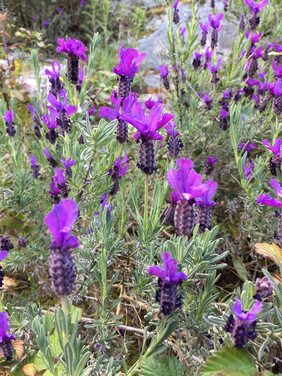
Lavandula stoechas

Tuberaria guttata
Goffredo had done the shopping in the morning and everybody carried something in their backpack. Even strawberries and loquats were safely carried to the lunch site and enjoyed, while the snow-capped mountains of Corsica could be seen on the horizon.

Glebionis coronaria near Giglio castello. Montecristo island is visible in the background

Ferry in the little port of Giglio island
On the way back, the surroundings of Giglio Castello were covered with huge plants of Glebionis coronaria (= Chrysanthemum coronarium).
Before taking the drive back to the port, the group took a short tour of the alleys in Giglio Castello, with their amazing architecture resulting from shortage of space; living outside the town walls was not an option until the early 1800s, because of the pirate attacks.

Borago officinalis in foreground and Pinus pinea behind


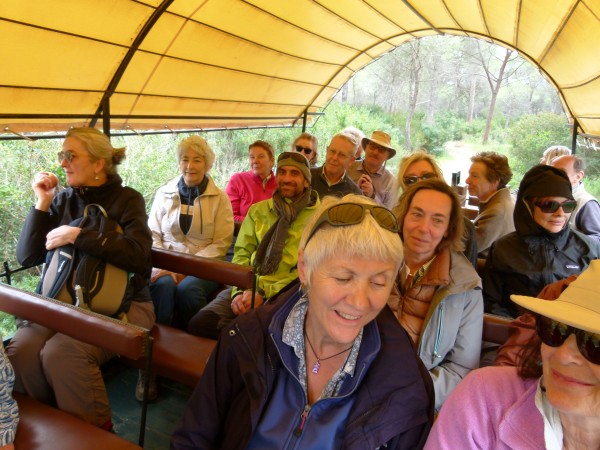
The tower was surrounded with Senecio cineraria and Anthirrhinum latifolium, while the cliff hosted Euphorbia dendroides and rare individuals of the dwarf palm Chamaerops humilis (spotted with binoculars). There were wide views over the pine forest in the alluvial plain. The group then climbed down across an ancient olive grove to the place where the carriage was waiting. We then visited a wide white-sand beach with soft dunes (dominated by Juniperus oxycedrus subsp. macrocarpa, and with lush flowering of the yellow Ononis variegata) behind, then had a picnic (arranged by the carriage drivers) in a clearing in the pine woods.
As well as the many plants, some shown in the pictures here, some of the group spotted cattle egrets, a great white egret, a roller, and a group of fresh-water terrapins which came quite close to us, hoping for some food).
The next day, Wednesday, was our last full day in the Monte Argentario area. We went to the 9000-hectare Maremma Regional Park which can be explored on foot, on horseback, by bike or in horse-drawn carriages. Goffredo had ordered a carriage which could carry us all and had planned routes for walkers, carriage riders and those who wanted some of each. There were hundreds of Pinus pinea planted in the 18th century but now threatened by disease. Many were dying.
It was “both wild and accessible – so rare nowadays,” as David Capps commented appreciatively. Most of the group hiked along a trail with many ups and downs in holm oak coppicewoods, passing by a pond surrounded by Paliurus spina-christi with its strange fruits until reaching – with one last steep climb – a medieval tower perched above a limestone cliff.
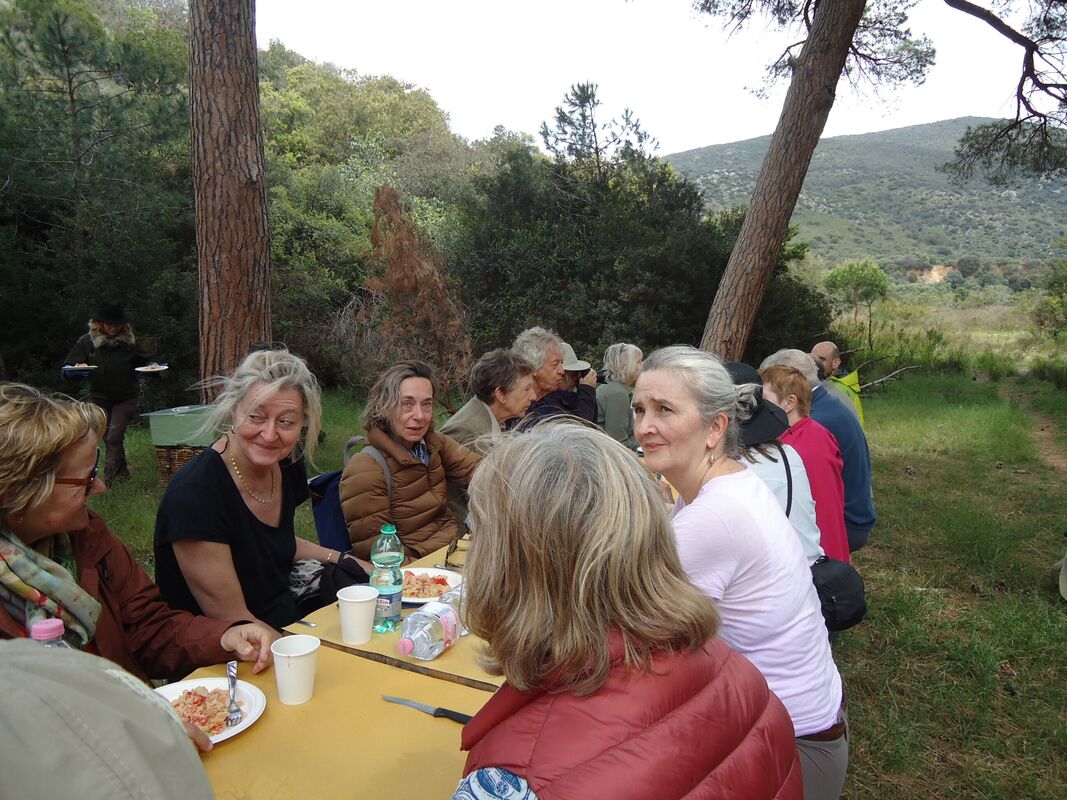


L to R Alan, Anne, Bob, Geraldine, Joey and Tim at Da Orlando
On most evenings in Porto Santo Stefano we ate dinner in the hotel which was convenient after the long days out and about, and this meant it was easy for members to look at Goffredo’s books on plants of the area, and to ask him questions or to identify plants on iPads and cameras. On the last evening, however, we went to the Ristorante da Orlando, across the road from the hotel for a pleasant change.

Anthemis maritima
On Thursday 9 May we checked out of Hotel La Caletta immediately after breakfast. The plan had been to go inland to Pitigliano and hike from there to Sovana but rain was forecast for that area in the morning so we went to Giannella beach, on one of the sand spits joining Monte Argentario to the mainland, and explored psammophytic plants including Centaurea sphaerocephala, Juniperus oxycedrus subsp. macrocarpa, Matthiola sinuata, Cakile maritima, Crucianella maritima and Anthemis maritima. Many people were puzzled by the hairy “balls” found in great number among the drifted materials on the beach. Goffredo explained they are formed naturally, through sea wave energy, from the rhizomes of Posidonia oceanica, an aquatic flowering plant endemic to the Mediterranean that lives on sandy seafloors and is very important in the ecological balance of sandy shores
When Goffredo judged that the rain would be clearing from our inland destinations we set off towards Pitigliano. Our driver paused for us to take photos when we first saw the town, dramatically set on a volcanic ridge, and we then stopped a couple of kilometres further on to walk part of the way up an ancient sunken road, cut into the tuff bedrock in Etruscan times (between about 700 to 300 BC).
It is possible to walk from this spot near Pitigliano up to Sovana but we were short of time by then and Goffredo didn’t advise the walk after the recent rain.
It was fascinating to see the very deeply cut corridors, which are sometimes more than 15 metres deep and are locally known as “vie cave” (excavated roads).

Pitigliano

Etruscan sunken road
I have read that these ancient routes always coincide with a necropolis and are, on average, about half a kilometre long and three metres wide. On the vertical sides there may be carvings of symbols and numbers from various periods – Etruscan, Roman and Medieval. There are some 10 Etruscan pathways in the valley of Pitigliano.
As we arrived in Sovana, we were greeted by Carol Smith as we were walking along the beautiful main street towards the Trattoria La Tavernetta for lunch. Carol created and organised MPG’s popular and praised garden tour in and around Lucca in 2015.

Serapias lingua on the tuff pavement near Sovana
Carol had come from her home near Cortona to meet us. We all had lunch together (including a fabulous vegetable stew soup known as “Acquacotta” – the traditional meal of Maremma’s farmers from the old days) then explored the lovely half-abandoned village of Sovana.
I spent the afternoon with Carol while the others continued to walk another section of the Pitigliano-Sovana hike, a plateau with tuff pavements where they were excited to discover a massive flowering of thousands of the orchid Serapias lingua, blanketing the grassland over many hectares. Even Goffredo was surprised by such a huge population. More orchid species, such as Orchis papilionacea, Orchis morio and Limodorum abortivum grew among the Serapias. In wetter microsites on the tuff pavement, the tiny annual daisy Bellis annua grew with Briza minima. The country lane verges offered Aristolochia rotunda and huge individuals of Sylibum marianum.
Finally, the group drove to Sorano with just one last brief stop at San Rocco where they enjoyed amazing views over Sorano and its gorge from a lookout surrounded by Quercus pubescens trees. We all checked in to Sorano’s Hotel della Fortezza, an ancient fortress with bedrooms of contrasting characters and qualities and wonderful views.
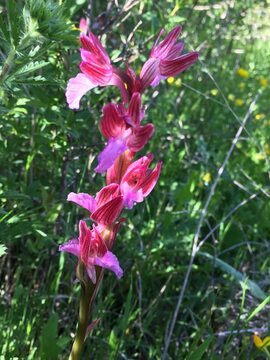
Orchis papilionacea

Hotel della Fortezza dominates Sorano and has wonderful views of the old town

Breakfast is laid out on the bar and on this old table made for gold jewellery makers
We had an excellent dinner at Ristorante Fidalma, five minutes from the hotel down a cobbled lane. The pasta is home-made, everything was delicious, and the warm owner, who struck me as a typically Italian nonna, came and thanked Goffredo warmly for bringing us all to her restaurant.
We had been told that the following day we would have a different bus and driver as Marco would be taking our usual 26-seater coach for its annual check-up. We went in a rather older bus with a silent driver north to Monte Penna Nature Reserve in the commune of Castell’Azzara.
As we drove through countryside with clay hills, green fields and hedgerows, hilltop houses and sheep, we caught occasional glimpses of Italy’s fifth largest lake, Bolsena, originally a volcano. In places we could look back and make out Giglio Island and Monte Argentario.
The morning walk was in woodland at the beginning, mainly Quercus cerris (Turkey oak). Laura joined us once again for this day. We heard a loud cuckoo and lots of birdsong, and saw orchids (perhaps Dactylorhiza fuchsii), Acer obtusatum, Anemone apennina, Pulmonaria hirta, plenty of Helleborus foetidus and Smyrnium perfoliatum, as well as huge rocks covered with moss. Laura and Goffredo were amazed that some plants supposed to flower in late winter and early spring were still flowering because of the exceptionally low temperatures, such as Primula vulgaris and Corydalis cava. Most of the group made it to the top of Monte Penna at 1,100 metres (3,600 feet) but I didn’t do the trickier bit which was partly on rough and stony limestone slopes with no path. This latter section crossed some rocky grassland patches and ridges that featured interesting mountain species – relatively common in the Apennines but quite unusual for the Maremma district – such as Hesperis matronalis and Scrophularia vernalis. Also of interest was the occurrence of the eastern Mediterranean Anchusella cretica (in flower), that apparently has here its northernmost population in Italy. From the top, the group enjoyed beautiful views over Monte Argentario and Giglio.



Moss
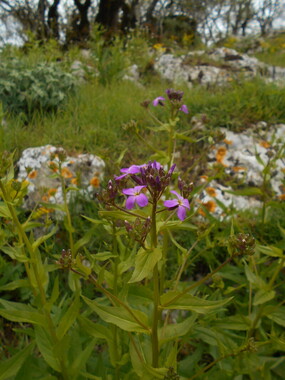
Hesperis matronalis coming in to flower: widely introduced in UK, native to montane Italy, within Maremma found only on the top of Monte Penna

Climbing Mount Penna
Lunch was at Il Cornacchino, an “agriturismo” (a farm with accommodation for tourists) near the start of our trail. The people were superbly friendly and everyone appreciated there being a menu on a blackboard so that, for once, we were able to pace ourselves and not eat so much of the first course that we couldn’t fit in anything else.
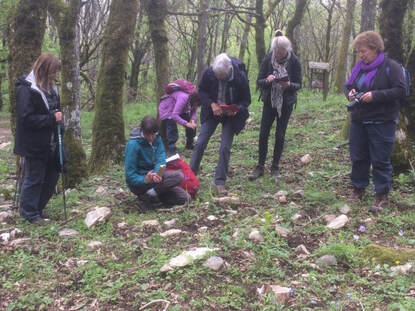

Helleborus foetidus

Smyrnium perfoliatum and Lamium ?garganicum near the top of Mt. Penna
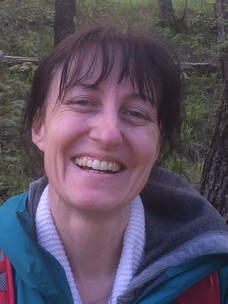
Laura Cancellieri

Plant identification in the Pigelleto Nature Reserve
We finished the afternoon with a walk in Quercus cerris and Abies alba native woodland in the Pigelleto Nature Reserve and found many orchids (including Listera ovata and Cephalanthera longifolia).
Back at the hotel Goffredo offered a final plant identification session before dinner at the Ristorante Fidalma. This last dinner consisted of antipasti, wonderful pasta, then wild boar, panna cotta and coffee.
On Saturday morning, the day of our departure, we sadly said our warm goodbyes to Goffredo at the bus. He had provided a tremendous range of experiences – geographical, botanical, historical and culinary – always calmly. We never felt rushed yet, on the other hand, we’d all have liked to have spent more time there.

Group at Hotel della Fortezza, but unfortunately missing Kate and Christine who were having a leisurely breakfast!
Text: Heather Martin with botanical contributions from Goffredo Filibeck
Photos: Goffredo Filibeck, Anne Keenan, Heather Martin, Anne Rendell, Jill Sheppard

